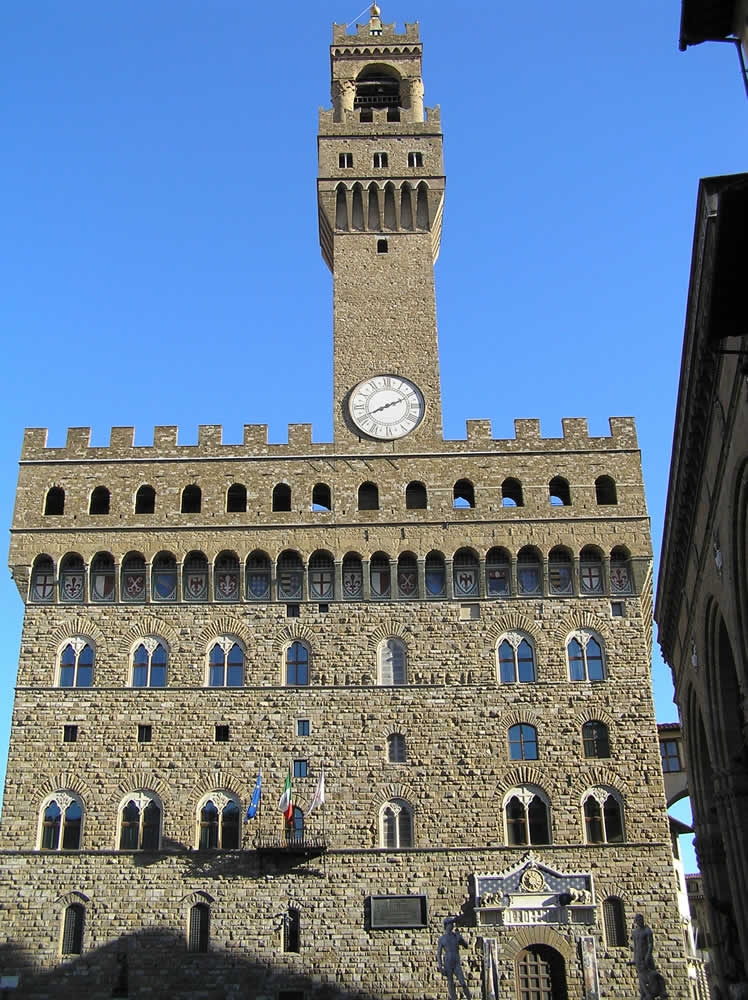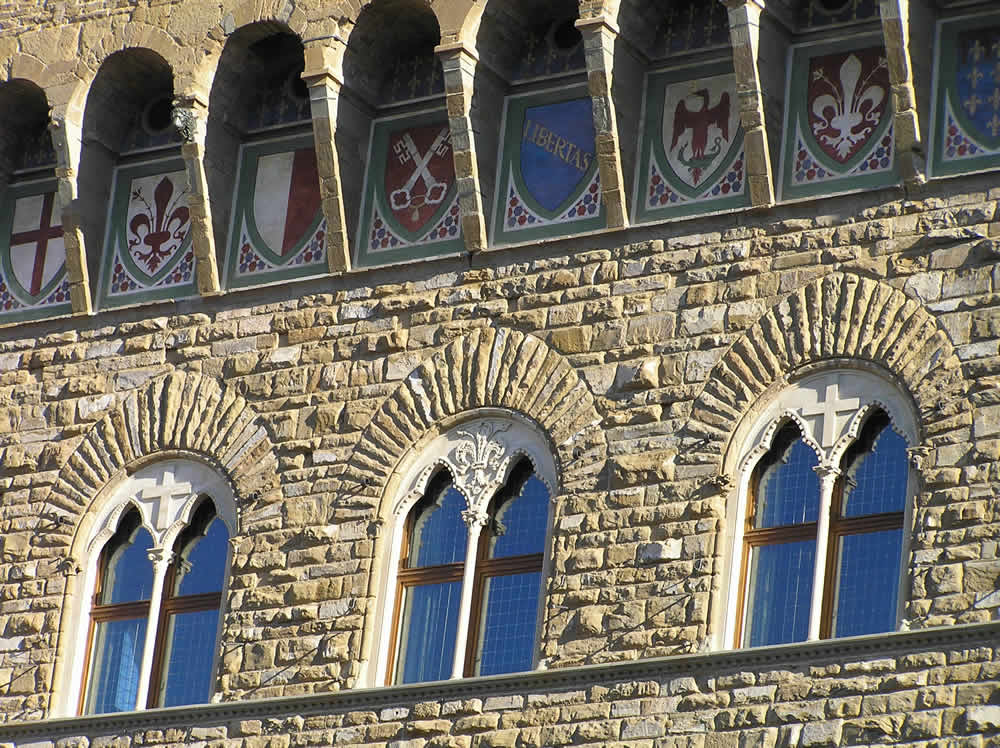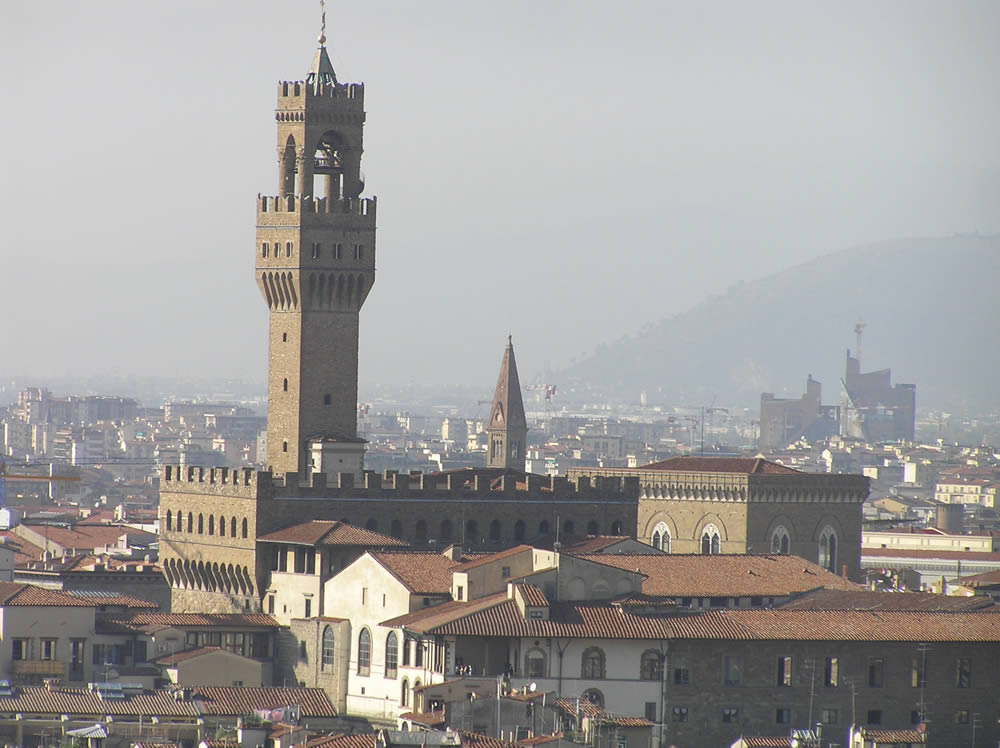Questo articolo è disponibile anche in:
![]() Français
Français ![]() Deutsch
Deutsch ![]() Español
Español ![]() Italiano
Italiano
One of the symbols of Florence, Palazzo Vecchio or Palazzo della Signoria was designed by Arnolfo di Cambio around 1299 as the residence of the Priors of the Arts, the palace was completed in 1314. The 94-meter-high tower of Palazzo Vecchio, called the tower of Arnolfo was built in 1310, together with the palace. It was probably supported by an older tower called Torre de’ Foraboschi. The tower was finished in 1453 with the erection of a cusp, a bronze sphere and the Marzocco (the lion symbol of Florence). Palazzo Vecchio overlooks Piazza della Signoria.
THE RESIDENCE OF THE CITY GOVERNMENT
Palazzo Vecchio was the residence of the Signoria during 15th century and later was restructurated by Vasari when, in 1540, Cosimo I de’ Medici moved into the palace with his family. In 1865, when Florence was the capital of the kingdom of Italy it became the seat of United Italy’s government from 1865-71, and housed the Chamber of Deputies (the Senate sat next door in the Uffizi). It was to return to its original function as the seat of the City Council in 1872.

Although the palace today contains the offices of the City Council, much of it can still be visited. Beautiful it is the decorated courtyard of access to the palace. Between the rooms to not be missed are the Salone dei Cinquecento, the Studiolo di Francesco I and the four monumental appartments: the Quartiere degli Elementi, the Quartiere di Eleonora, the Residenza dei Priori and the Quartiere di Leone X.
The Salone dei Duecento is being used for the meetings of the City Council and therefore not always open to the public. Inside the Palace are frescoes carry out by artists as the Ghirlandaio, Francesco Salviati, the Bronzino, Vasari. There are also masterpiece of sculpture’s renaissance as the Genio della Vittoria by Michelangelo and the Donatello’s bronze of Giuditta e Oloferne. Next to Palazzo Vecchio is the beautiful Loggia dei Lanzi or Loggia della Signoria with several beautiful sculptures the most famous is the Perseus of Benvenuto Cellini.

INFORMATION
Type of objects: frescos, sculptures, paintings, furniture.
Important works: Among the most important works are the Victory statue by Michelangelo in the Salone dei Cinquecento, the Judith by Donatello, the winged cherub by Verrocchio. Moreover Ghirlandaio frescoes in the Sala dei Gigli, Salviati frescoes in the Audience Hall, Bronzino frescoes in the Chapel of Eleonora and Vasari frescoes in Salone dei Cinquecento and in the Medicean quarters. Refined collective witness of the late Florentine Mannerist is the study of Francesco I.
Address: piazza della Signoria Firenze Tel: 055-2768325 E-mail: gestione.musei@comune.firenze.it
Opening Hours: 9-19 hours; Thursday and public holidays midweek 9-14 hours. Closed for New Year’s Day, Easter, May 1, August, Christmas.
Price: 6.00 €; 4.50 € reduced youth 18-25 years and elderly over 65 years € 4.50; reduced for children 3-17 years and 2.00 € schools. Family ticket for 4 persons (2 adults, 2 children) 14.00 €; family 5 persons (2 adults, 3 children) 16.00 €.
Handicap access: YES
Exhibition area: 3284 sqm
Exhibition halls: 35
We enter now in the Palace and we begin our visit in the Courtyard.
Questo articolo è disponibile anche in:
![]() Français
Français ![]() Deutsch
Deutsch ![]() Español
Español ![]() Italiano
Italiano

